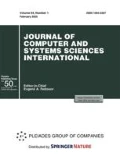Abstract
The problem of minimizing wind perturbations using the control on the trailing edge of the airfoil is considered for an airfoil passing through a short wind gust. It is considered that the airfoil movement is bounded by two degrees of freedom, viz. in pitch and height, and each channel has an elastic spring that simulates torsional and bending stiffness of the wing. The study is held on the basis of the developed mathematical model for unsteady aerodynamic loads (the lift coefficient and the pitching moment) when a thin two-dimensional airfoil is flowed without separation by a flow of ideal incompressible fluid. The results obtained using this mathematical model and the conventional quasi-steady model on the basis of aerodynamic derivatives are compared. It is shown that the stability properties for the quasi-steady and unsteady aerodynamics models differ in a wide range of parameters of the airfoil movement considered. Moreover, taking into account the unsteadiness of aerodynamics when designing a control system allows us to suppress the wind perturbations more efficiently and counts when determining the requirements on the actuator rates necessary to suppress wind gusts of high amplitude.
Similar content being viewed by others
References
Aerodynamics, Stability, and Controllability of Supersonic Aircraft (Nauka. Fizmatlit, Moscow, 1998) [in Russian].
M. Goman, Y. Patel, and M. Sidoryuk, “Regions of Attraction for Robustness Assessment,” in Proceedings of AIAA Guidance, Navigation and Control Conference and Exhibition, Austin, Texas, 2003.
T. Theodorsen, “General Theory of Aerodynamic Instability and the Mechanism of Flutter,” NACA Report, No. 496 (1935).
A. N. Khrabrov, “Mathematic Simulation of the Effect of Coming off Whirlwinds on Unsteady Aerodynamic Characteristics of the Airfoil under Its Arbitrary Motion,” Uch. Zap. Tsentr. Aerogidrodin. Inst. 33(3, 4), 3–17 (2002).
A. N. Khrabrov, “Mathematical Simulation of Unsteady Aerodynamic Loads on the Airfoil under Dynamic Deflection of the Control on the Trailing Edge,” Izv. Akad. Nauk, Ser. Mekh. Zhidk. Gaza, No. 3, 157–169 (2005).
N. Singh and M. Brenner, “Modular Adaptive Control of a Nonlinear Aeroelastic System,” in Proceedings of AIAA Guidance, Navigation, and Control Conference and Exhibition Austin, Texas, USA, 2003.
V. Mukhopadhyay, “Transonic Flutter Suppression Control Law Design and Wind-Tunnel Test Results,” J. Guidance, Control, and Dynamics 23(5), 930–937 (2000).
M. R. Waszak, “Modeling the Benchmark Active Control Technology Wind-Tunnel Model for Application for Flutter Suppression,” AIAA Paper, No. 96-3437 (1996).
S. Gujjula, N. Singh, and W. Yim, “Limit Cycles and Domain of Stability in Unsteady Aeroelastic System,” J. Guidance, Control, Dynamics 27(4), 728–732 (2004).
J. Doyle, K. Glover, P. Khargonekar, et al., “State-Space Solutions to Standard H2 and H Control Problems,” IEEE Trans. Automat. Control 34(8), 831–847 (1989).
G. Balas, J. Doyle, K. Glover, et al., “MATLAB,” Analysis and Synthesis Toolbox. Natick: The MathWorks Inc (1991).
P. Gahinet, A. Nemirovsky, A. Laub, et al., MATLAB LMI Control Toolbox. Natick: The MathWorks Inc. (1995).
M. Chilary and P. Gahinet, “H∞ Design with Pole Placement Constraints: An LMI Approach,” IEEE Trans. Automat. Control 40 (1995).
P. Apkarian and P. Gahinet, “A Convex Characterization of Gain-Scheduled H∞ Controllers,” IEEE Trans. Automat. Control 40(5) (1995).
K. Glover, “All Optimal Hankel-Norm Approximations of Linear Multivariable Systems and Their L ∞ Error Bounds,” Int. J. Control 39, 1115–1193 (1984).
Author information
Authors and Affiliations
Additional information
Original Russian Text © M.G. Goman, M.E. Sidoryuk, A.N. Khrabrov, 2006, published in Izvestiya Akademii Nauk. Teoriya i Sistemy Upravleniya, 2006, No. 5, pp. 139–150.
Rights and permissions
About this article
Cite this article
Goman, M.G., Sidoryuk, M.E. & Khrabrov, A.N. On unsteady aerodynamic airfoil loads in the design of a control system for minimizing the effect of wind perturbations using the rudder on the trailing edge of the wing. J. Comput. Syst. Sci. Int. 45, 812–823 (2006). https://doi.org/10.1134/S1064230706050121
Received:
Issue Date:
DOI: https://doi.org/10.1134/S1064230706050121



